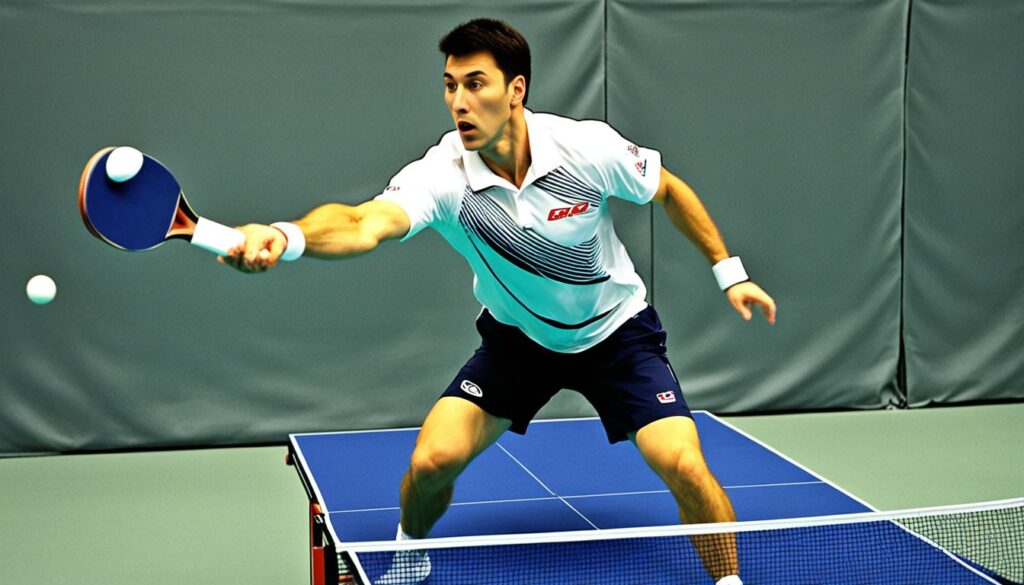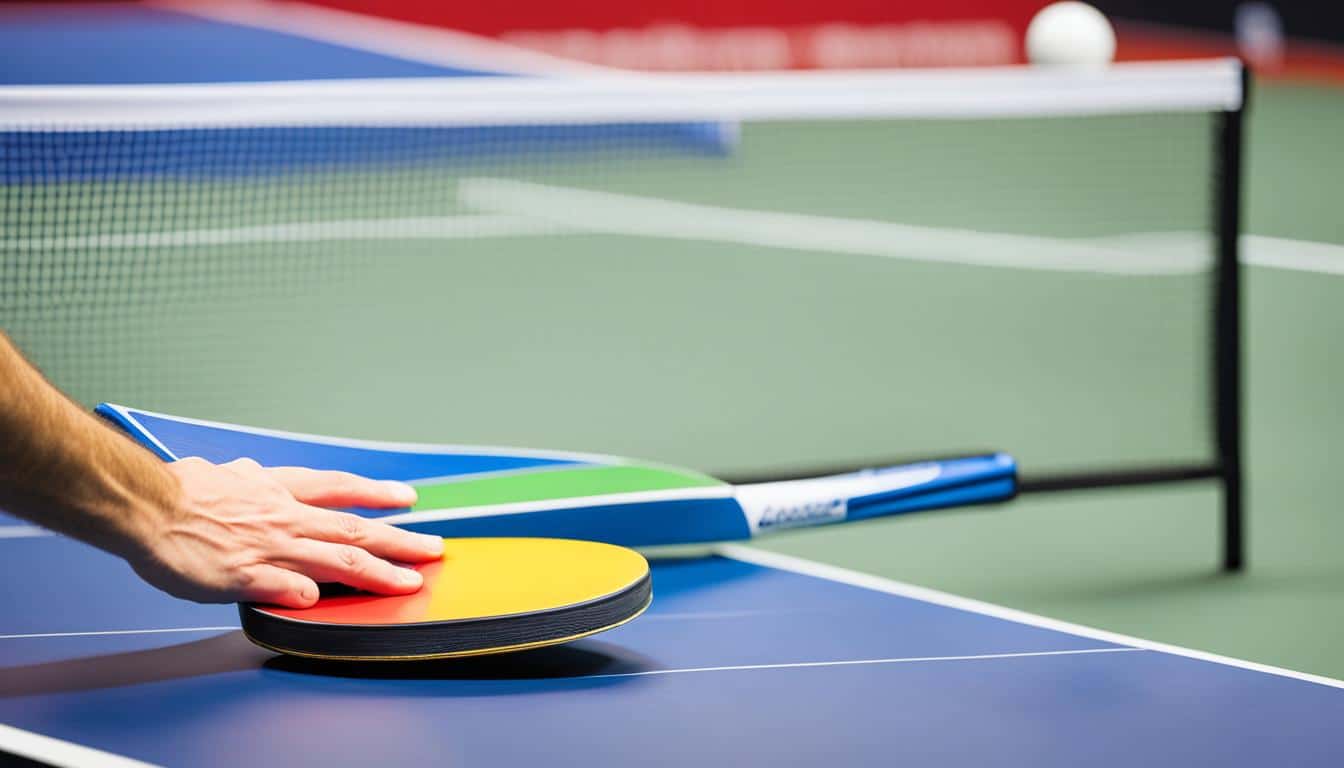Table tennis, also known as ping pong, is a popular and fast-paced sport that requires skill, technique, and strategy. Whether you’re a beginner or an advanced player, mastering the basics and learning effective tips can elevate your game and help you dominate the table. In this article, we will explore essential techniques, tactics, and advice from experts to improve your table tennis skills at any level.
Key Takeaways:
- Understanding spin and racket angles is crucial to responding effectively to different types of spins.
- Proper body movement and maintaining a good ready position can significantly improve your agility and speed on the table.
- Consistent practice is key to developing automatic skills and progressing as a table tennis player.
- Choosing the right equipment and mastering various types of serves can enhance your performance.
- Employing tactics and strategies such as controlling the pace and attacking first can improve your chances of winning matches.
Understanding Spin and Racket Angles
In the fast-paced sport of table tennis, being able to read and respond to the spin on the ball is a crucial skill. By paying close attention to your opponent’s racket and understanding the different spin effects, you can adjust your racket angle to counter the spin and gain an advantage in the game.
Spin: The rotation of the ball as it moves through the air.
Racket Angle: The position of your racket face when making contact with the ball.
Topspin: When your opponent’s racket moves from low to high, the ball will have topspin. To counter this, angle your racket face down and contact the ball above its center. This will help you control the ball and counter the topspin effectively.
Backspin: If the ball has backspin, your opponent’s racket face will be moving from high to low. In this case, angle your racket face up and contact the ball below its center. This will neutralize the backspin and allow you to return the ball effectively.
Sidespin: Sidespin occurs when your opponent imparts a sideways rotation on the ball. Right sidespin requires angling your racket face to the right and contacting the ball to the left of its mid-line. Conversely, left sidespin requires angling your racket face to the left and contacting the ball to the right of its mid-line. By adjusting your racket angle accordingly, you can counteract the sidespin and control the ball’s trajectory.
Mastering spin and racket angles is essential in table tennis to effectively respond to different types of spins and gain an advantage over your opponent.
Importance of Body Movement and Ready Position

In table tennis, body movement plays a crucial role in executing powerful and accurate strokes, especially when it comes to the forehand shot. By incorporating proper body movement, you can enhance your power, consistency, and overall performance on the table. One key aspect of body movement is the rotation of your hips and shoulders during the backswing. This rotation allows you to generate more force and transfer it effectively to the ball when striking.
Another essential element of body movement is transferring your weight from the back foot to the front foot as you make contact with the ball. This weight transfer adds momentum to your shots and enables you to maintain balance and control throughout the stroke. By utilizing your entire body in the execution of your strokes, you can maximize your power and accuracy on each shot.
Additionally, maintaining a good ready position is essential in table tennis. This position involves being balanced and ready to move in any direction at a moment’s notice. Whether you’re preparing to return a serve or transitioning between strokes, being in a proper ready position allows you to react quickly and effectively to your opponent’s shots. It also allows you to maintain a stable base, enabling better footwork and agility on the table.
By incorporating proper body movement and adopting the right ready position, you can improve your footwork, speed, and overall performance on the table. So, remember to rotate your hips and shoulders, transfer your weight effectively, and be in a balanced ready position to maximize your potential in table tennis.
The Art of Practice and Skill Development

Practice is essential for improving your table tennis game. When learning new skills, you initially use a lot of mental energy to understand and visualize the stroke. However, with consistent practice, these skills become automatic, allowing you to perform them without conscious thought. It is crucial to train your strokes until they become automatic, enabling you to focus on the game rather than analyzing your techniques.
“The key to mastery is turning the automatic stage into your default mode of play.”
Furthermore, practicing with a partner or a table tennis robot can provide valuable feedback and help you refine your skills. Regular and focused practice is the key to honing your abilities and progressing as a table tennis player.
Benefits of Regular Practice
Regular practice offers numerous benefits for skill development in table tennis:
- Improves muscle memory and reflexes
- Enhances hand-eye coordination and timing
- Increases consistency and precision in shots
- Builds stamina and endurance
Practicing with a Partner
Practicing with a partner adds a dynamic element to your training sessions. It enables you to engage in rallies, simulate game-like scenarios, and work on various strategies. Additionally, practicing with a partner allows you to:
- Sharpen your shot accuracy by receiving and returning different shots
- Develop your footwork and movement patterns during live play
- Improve your anticipation skills by reading your partner’s shots
Utilizing Table Tennis Robot
A table tennis robot is a valuable tool for solo practice sessions. It can simulate shots with different spins, speeds, and trajectories, providing consistent practice opportunities. Using a table tennis robot allows you to:
- Focus on repetitive drills to strengthen specific strokes
- Train against various spin and shot combinations
- Practice specific game situations, such as return of serves
Tracking Progress
Monitor your progress and improvement by tracking key performance indicators during practice sessions. This can include tracking the number of shots executed, success rate of specific shots, and overall game stats. Analyzing your practice data provides valuable insights into your strengths and weaknesses, helping you refine your training approach.
| Key Performance Indicators | Benefits |
|---|---|
| Shot Accuracy | Identify areas for improvement and track progress over time |
| Shot Consistency | Evaluate the reliability and precision of your shots |
| Footwork Efficiency | Measure agility and movement on the table |
| Service Success Rate | Assess your ability to execute various serves effectively |
By incorporating regular practice sessions, utilizing practice partners, and leveraging the benefits of a table tennis robot, you can accelerate your skill development and progress towards mastering the art of table tennis.
The Importance of Equipment and Serves

Choosing the right equipment is crucial in table tennis. Using your own paddle or table tennis racket exclusively allows you to adapt and become familiar with its playing characteristics, leading to improved performance on the table. It’s recommended to invest in a high-quality racket that suits your playing style and preferences, whether you prefer a defensive or offensive approach.
Proper care and maintenance of your racket are equally important. Keeping it in a protective case when not in use helps prevent damage and prolongs its lifespan. Regularly cleaning your racket with a mild soap and water solution ensures that the rubber surface remains tacky and provides optimal grip during play.
Mastering various types of serves is another key factor in gaining a strategic advantage in table tennis. The serve is the only shot in the game where you have complete control over the ball, allowing you to dictate the pace and set up your next shot. By developing a repertoire of short, deep, and spin serves, you can keep your opponents guessing and disrupt their rhythm.
Below is an example of a table highlighting the different types of serves and their characteristics:
| Serve Type | Description | Effect |
|---|---|---|
| Short Serve | A low trajectory serve that bounces twice on the opponent’s side of the table. | Forces the opponent to approach the net, making it difficult to attack. |
| Deep Serve | A long and fast serve that lands near the edge of the table. | Pushes the opponent away from the table, allowing you to control the rally. |
| Spin Serve | A serve with a high degree of spin, which can be topspin, backspin, or sidespin. | Creates unpredictable ball trajectories and makes it challenging for the opponent to return with accuracy. |
By selecting the appropriate equipment and honing your serving techniques, you can enhance your overall performance on the table and become a formidable opponent.
Tactics and Strategies for Winning Matches

Table tennis is more than just hitting the ball back and forth; it requires the implementation of effective tactics and strategies to come out on top. By employing the right tactics, you can gain an advantage over your opponents and increase your chances of winning matches.
One key tactic is to control the pace of the game. Varying the speed and tempo of your shots can disrupt your opponent’s timing, leading to mistakes on their part. By controlling the pace, you dictate the rhythm of the match and force your opponent to adjust constantly.
Another important strategy is to attack first whenever possible. By taking the initiative and putting pressure on your opponent, you set the tone of the rally and control the flow of the game. When you attack first, you force your opponent into a defensive position, giving you the upper hand.
Returning serves correctly is also crucial to success. By mastering the art of returning serves, you can neutralize your opponent’s advantage and gain control of the rally. Understanding the spin, speed, and placement of the serve will enable you to anticipate and execute the appropriate return.
Utilizing different tactics throughout the match can also give you an edge. By identifying your opponent’s weak spots and targeting them, you can exploit their vulnerabilities and force them into difficult situations. Mixing up your shots with varying spin, speed, and placement adds an element of unpredictability, making it harder for your opponent to anticipate your next move.
“In table tennis, tactics and strategies play a significant role in gaining the upper hand against opponents. By controlling the pace, attacking first, returning serves effectively, and using different tactics, you can elevate your game and increase your chances of winning matches.” – Table Tennis Pro
By incorporating intelligent tactics and strategies into your game, you can become a more formidable player and increase your chances of success on the table.
| Tactics and Strategies | Description |
|---|---|
| Control the Pace | Vary the speed and tempo of your shots to disrupt your opponent’s timing. |
| Attack First | Put pressure on your opponent by taking the initiative and setting the tone of the rally. |
| Return of Service | Master the art of returning serves to neutralize your opponent’s advantage. |
| Utilize Different Tactics | Target weak spots, mix up shots, and keep your opponent guessing. |
Implementing effective tactics and strategies can be the difference between winning and losing in table tennis. By honing your skills and incorporating these strategies into your game, you can elevate your performance and achieve success on the table.
Importance of Footwork and Timing

Footwork and timing are crucial elements in the game of table tennis that are often overlooked but immensely impactful. Mastering these aspects can significantly enhance your performance on the table, allowing you to outmaneuver your opponents and execute shots with precision and power.
Footwork involves moving quickly and efficiently to position yourself correctly for each shot. This skill ensures that you are always in the best possible position to strike the ball accurately and generate maximum power. By improving your footwork, you can maintain a strong and balanced stance, enabling you to react swiftly and reach every ball with ease.
Timing is equally important, as it allows you to capitalize on your opponent’s weaknesses and execute effective shots. Hitting the ball at the right moment maximizes your chances of achieving optimal spin, speed, and accuracy. It enables you to anticipate and respond to your opponent’s shots with precision, providing you with a distinct advantage in rallies.
To master footwork and timing, practice specific drills that focus on quick movement and precise timing. Incorporate exercises that simulate different game situations, such as lateral movement, diagonal footwork, and split-step drills. These drills improve your agility, speed, and overall positioning on the table.
“Good footwork and timing are the foundations of a successful table tennis player. They enable you to be proactive rather than reactive, giving you more control over the game.” – Sarah Li, Table Tennis Champion
Additionally, pay attention to your body position during strokes. Maintaining a balanced and centered posture ensures that your weight is properly distributed, allowing for optimal movement and improved footwork. Focus on staying light on your feet, using small and quick steps, and adapting your footwork to suit different shot angles and positions on the table.
By honing your footwork and timing, you can elevate your level of play in table tennis. These skills enhance your overall agility and positioning on the table, enabling you to consistently reach and strike the ball with accuracy. Incorporate footwork and timing drills into your practice routine, and observe the positive impact they have on your performance.
Benefits of Improving Footwork and Timing
- Enhanced agility and quickness on the table
- Better positioning for accurate and powerful shots
- Improved ability to anticipate and respond to opponent’s shots
- Increased control over the game
- Reduced chances of being caught off balance
Practice Partners and Finding a Table Tennis Club

To advance your game and reach new heights in table tennis, it is essential to find practice partners and join a table tennis club. Training and practicing with others who have similar goals and playing levels can provide valuable opportunities for improvement.
Table tennis clubs are known for their supportive and competitive environments, attracting players of varying skill levels. These clubs offer a dynamic and engaging atmosphere where you can constantly challenge yourself and hone your skills. Additionally, many table tennis clubs have experienced coaches who can provide expert guidance and help you develop your game.
By connecting with other players and utilizing the resources available at a table tennis club, you can accelerate your progress and enhance your overall performance. Training with like-minded individuals fosters healthy competition, pushes you to strive for excellence, and motivates you to continuously improve.
Remember, finding the right practice partners and joining a table tennis club can significantly contribute to your game improvement and enjoyment of the sport.
Benefits of Practice Partners and Table Tennis Clubs
Here are some key benefits of practicing with partners and joining a table tennis club:
- Varied Skill Levels: Playing with individuals of different skill levels challenges you to adapt, learn new strategies, and enhance your overall playing ability.
- Healthy Competition: Table tennis clubs provide a competitive environment that motivates you to push your limits and improve your game.
- Expert Coaching: Many clubs have experienced coaches who can offer valuable insights, technique refinement, and personalized training.
- Structured Training Programs: Table tennis clubs often offer structured training programs tailored to different skill levels, helping you focus on specific areas of improvement.
- Networking Opportunities: Connecting with fellow players who share your passion for table tennis allows you to exchange knowledge, learn from each other, and build lasting friendships.
“Practicing and training with practice partners at a table tennis club not only enhances your technical skills but also provides a sense of community and camaraderie. The collaborative environment pushes you to continuously improve and enjoy the sport to the fullest.”
Whether you are a beginner looking to refine your technique or an advanced player aiming to take your game to the next level, partnering with other players and becoming part of a table tennis club can play a pivotal role in your journey towards game improvement and mastery.
| Benefits | Practice Partners | Table Tennis Club |
|---|---|---|
| Varied Skill Levels | ✔️ | ✔️ |
| Healthy Competition | ✔️ | ✔️ |
| Expert Coaching | ❌ | ✔️ |
| Structured Training Programs | ❌ | ✔️ |
| Networking Opportunities | ✔️ | ✔️ |
In the game of table tennis, played between two players or pairs, the table tennis table is divided into two equal sides, and according to the table tennis rules, the first player to score 11 points wins the game unless both players reach 10 points, in which case the game continues until one player gains a 2-point advantage.
The ball, typically a standard white or orange ping pong ball with a diameter of 40mm, must bounce at least once on the opponent’s half of the table after being hit, and if the ball hits the net but still goes over to the opponent’s side, it remains in play. The serving rules dictate that the player who served must choose which side of the table to serve to and must hide the ball in one hand before serving to make it harder for the opponent to guess which hand the ball is in. The opponent then has the right to inspect the server’s hand to ensure they are not hiding the ball.
The style of play, asities the professional ping pong uses, can vary greatly among table tennis players, with some favoring offensive strategies while others adopt defensive techniques. The United States Table Tennis Association oversees table tennis events in the country, including the selection of players for international competitions such as the ITTF World Team Championships and the ITTF World Cup.
Founded in 1926, the association establishes the rules and regulations for table tennis competitions, ensuring fair play and standardization across all levels of the sport, from amateur lawn tennis matches to professional championships held at the Olympic Games and World Table Tennis Championships.
Also Read : Your Go-To Guide To Badminton Essentials
Conclusion
Table tennis is a sport that offers endless opportunities for improvement and mastery. By incorporating the right techniques, tips, and strategies into your game, you can elevate your skills and achieve success on the table. Mastering the basics is essential, as it provides a solid foundation for building more advanced techniques. Understanding spin and racket angles allows you to read and respond to your opponent’s shots effectively. Utilizing proper body movement and adopting a ready position enhances your agility and speed. Implementing intelligent tactics and strategies gives you a competitive edge, while mastering footwork and timing allows you to outmaneuver your opponents.
Consistent practice is the key to improvement. By dedicating time and effort to honing your skills and developing automaticity in your technique, you can establish a strong foundation. Playing with the right equipment, maintaining and caring for your racket, and mastering diverse serving techniques further enhances your performance. Additionally, seeking out practice partners and joining a table tennis club provides valuable opportunities for growth and learning. With the right guidance and support, you can continually enhance your skills and strive for mastery in this thrilling sport.
So, grab your paddle, implement these tips and techniques, and immerse yourself in the world of table tennis. Whether you’re a beginner or an advanced player, there is always room for improvement. Embrace the challenge, enjoy the thrill of the game, and become a formidable player at any level. With dedication, practice, and a passion for the sport, you can take your table tennis skills to new heights and achieve mastery.
FAQs
Q: What is table tennis?
A: Table tennis, also known as ping pong, is a popular indoor sport where two players or two teams of two players each hit a lightweight ball back and forth across a table using table tennis paddles.
Q: What are the basic rules of table tennis?
A: The basic rules of table tennis include serving diagonally across the table, hitting the ball over the net, letting the ball bounce on your side of the table once before returning it, and scoring points when your opponent fails to make a legal return.
Q: How do I serve in table tennis?
A: To serve in table tennis, stand behind the end of the table, toss the ball up at least 6 inches in the air, and hit the ball so that it bounces on your side of the table first, then clears the net and bounces in your opponent’s half of the table.
Q: What are some common table tennis terms?
A: Some common table tennis terms include ITTF (International Table Tennis Federation), double (a match with two players on each side), and table tennis table (the surface on which the game is played).
Q: Can you play table tennis outdoors?
A: Yes, there are outdoor table tennis tables designed specifically for playing table tennis outside. These tables are weather-resistant and can withstand outdoor conditions.
Q: What is the order of play in table tennis?
A: The order of play in table tennis typically follows a sequence where one player serves, the other player returns the serve, and play continues until a point is scored or a fault is committed.
Q: How do table tennis competitions work?
A: Table tennis competitions involve players or teams competing against each other based on official rules and regulations set by organizations like the ITTF. Matches are played in a series of games or sets to determine the winner.





